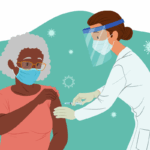Tremors are the most familiar symptom of Parkinson’s disease. Most people with Parkinson’s will develop a tremor at some point, but there are often subtler symptoms that will appear first. These may go unnoticed or be attributed to aging. However, Parkinson’s disease can affect many aspects of the body and daily life.
Progression of Parkinson’s Disease
The progression of Parkinson’s disease is different for each person and often slow and subtle. The four main symptoms are tremor in hands, arms, jaw or head, muscle stiffness, slow movements, and impaired balance and coordination. It may not be until these more dramatic symptoms appear that people begin seeking treatment.1
Symptoms from Parkinson’s disease begin because nerve cells in the area of the brain that produce the chemical dopamine are damaged. The loss of dopamine in this area results in difficulty moving. By time symptoms appear, there is often already significant damage to these cells with 60-80% already lost.2
Other Symptoms of Parkinson’s Disease
While movement symptoms may be the most noticeable, there are other lesser-known symptoms that often appear first. Some of these may be related to the progressing movement difficulties. Since Parkinson’s usually begins around age 60, many of these symptoms could be ignored as simple aging. However, it’s important to consider these together when deciding whether to talk to a doctor about a possible Parkinson’s diagnosis.3
Those with Parkinson’s will often experience changes in mood and cognition, including depression or anxiety. As the disease progresses, some people may also develop a form of dementia from the brain changes. A Parkinson’s diagnosis or the loss of independence that may come with its movement symptoms is undeniably difficult. However, depression can result from the brain chemistry changes of Parkinson’s. The Parkinson’s Foundation has found that these mood disorders have an even greater impact on well-being than the movement symptoms.4
The same changes that can make walking and other movements difficult can also impact the muscles that control speech. About 89% of people with Parkinson’s find that their voice often becomes quieter and more monotone. It may also sound breathy or unclear. Social interaction and communication are vital to maintaining quality of life and working with a speech therapist can help restore these abilities.5
Shrinking handwriting is also commonly associated with the neurological condition. This may be a result of increasing movement difficulties, small, cramped handwriting often appears as an early sign of the disease.6
Parkinson’s Disease Diagnosis & Prognosis
Why people develop Parkinson’s is still largely unknown. There may be a genetic component, as some cases can be traced to genes that run in families, but this is a small portion. Most people do not have relatives with the disease. Doctors believe it is most likely a combination of genetics and environmental factors.7
Researchers have identified that exposure to a common cleaning chemical is associated with a 500% increased risk of Parkinson’s disease. The chemical, trichloroethylene, has been used for decades to decaffeinate coffee, degrease metal, and dry clean clothes. More research is needed to fully understand this link.8
Another difficult part of diagnosis is that there is no direct test for Parkinson’s disease. Doctors must rely on a combination of symptom history, observation, neurological exam, and ruling out other similar conditions. Even brain scans of people will Parkinson’s disease usually appear normal.9
While there isn’t a cure yet, there are a variety of treatments that can help with symptoms. Since this neurological condition doesn’t affect life expectancy and is not in itself fatal, managing the symptoms can help limit the impact of the disease on quality of life.
1 National Institute on Aging, “Parkinson’s Disease: Causes, Symptoms, and Treatments”
2 National Institute of Neurological Disorders and Stroke, “Parkinson’s Disease”
3 MedlinePlus, “Parkinson’s Disease”
4 Parkinson’s Foundation, “Depression”
5 Parkinson’s Foundation, “Speech Therapy and PD”
6 Parkinson’s Foundation, “Small Handwriting”
7 National Institute of Neurological Disorders and Stroke, “Parkinson’s Disease”
8 SciTechDaily, “Scientists Warn: Common Cleaning Chemical Linked to 500% Increased Risk of Parkinson’s Disease”
9 National Institute of Neurological Disorders and Stroke, “Parkinson’s Disease”














